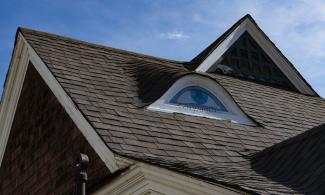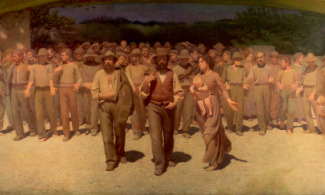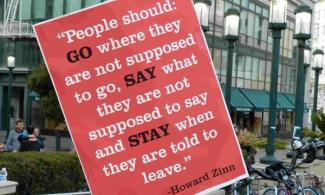
A Program of Community Building and Mutual Aid Affordable Housing
Preface:
We are in very difficult economic times for a growing number of people. Mortgages and rent will not be paid. For millions who are uninsured, health care won’t exist. Food, jobs, child care, education are becoming scarce. The November election results could provide help. The times also call for new approaches that aren’t dependent upon the state of American politics—that is “mutual aid.”
The program for cooperative housing offered here is one way to provide a partial answer to the crisis in which we now find ourselves.
There are two basic concepts to this program:
(1) Match elderly homeowners, who often live in mortgage-free or low-mortgage houses that were home for them, and their now-grown and departed children, and/or deceased spouse, with younger people looking for affordable housing.
Often a single elderly person is living in a three-or-more bedroom house. Typically a woman, she wants to remain in her home but it is too much space for her to easily maintain, she feels isolated, and she needs support to continue living independently.
(2) Engage religious congregations, union locals and other voluntary associations with living alone senior members, and seniors they know, and/or young people looking for housing as partners to provide support for the former and affordable housing for the latter. Such voluntary associations would establish a member committee to provide screening, recruitment, placement and social support for the program—identifying both homeowners and possible new residents.
A scenario:
Congregation (or union local) “x” identifies elderly members who live in a home such as the one identified above. Since the program is part of her congregation, and since congregation members will be involved in screening applicants and providing her with continuing support, her fears of having a stranger living in her home are substantially diminished, if not eliminated.
Participating organizations would also recruit potential residents. Three major sources are: (1) children, relatives and friends from their own association (congregation, union, etc), (2) students in schools of social work who are majoring in gerontology, social work or related fields, and (3) other organizations that have young members.
Identified homes would be listed in a common pool. A committee of association members, or a specially created nonprofit organization established for this purpose that is controlled by the voluntary associations, matches housing seekers with owners, provides common advertising for the program, trains and consults with the volunteer committees in participating associations (congregation, union, etc), has full-time support staff (social workers and others if needed), and otherwise provides continuing support to the program.
Cooperative Structure:
The enterprise is a cooperative. There would be two kinds of members—homeowners and those who want to become residents in those homes. The cooperative would be structured to protect the equity and other interests of the homeowners, while at the same time providing protection for the interests of new resident members.
By creating a cooperative, the structure mitigates against typical landlord – tenant issues, and makes possible a means of conflict resolution different from a publicly established rent board and/or courts.
I imagine a sliding scale, going from market rate to substantially subsidized (by the homeowner and/or the association)—i.e. this is not a “funded program” like Section 8, 221(d)(3) or some other HUD program. The homeowner is “giving back” to the community that is supporting her, him or them (if a senior couple) to overcome isolation, and making it possible for her, him or them to earn a substantial income from the home—which is likely to be their major asset in the world.
In some cases, a resident might be actively engaged in the life of the owner—as, for example, a live-in homecare provider or a sociable resident who becomes a friend. At the other end of the spectrum, the resident might simply live there and use the common kitchen and other shared facilities.
Mediation of conflicts:
The arrangement would make both the owners and residents “members” of a cooperative program. A monthly membership fee would entitle the payer to a share which translates into living space in the senior’s home. It might be paid to the administering agency rather than the individual homeowner, thus eliminating the headaches of collection for the owner.
Conflicts between owner- and non-owner residents (i.e. owners and tenants) could be resolved by a method known as “Mediation/Arbitration”, or “Med/Arb.” In this procedure, people engaged in a conflict formally agree to a neutral third party trying to get them to voluntarily come to an agreement. If, after a mutually agreed upon time period, voluntary agreement is not reached, then the third party imposes a solution. Members of the earlier-identified committees could be trained to do the mediation/arbitration. (The American Arbitration Association used to offer training in med/arb. I took the training a number of years ago.)
Before the conflict reaches this stage, a staff social worker might help the two parties resolve whatever the issue(s) might be.
Income:
Imagine, (and this is just an example):
-
A three bedroom house: one room at $1500; one room at $1000, and one room at $500 = $3,000 a month. (The low-income rate would be one quarter of the income of a person making $24,000 a year.) Cost could vary according to amenities.
-
Forty participating houses: $120,000/month; $1,440,000/year.
-
“X” amount of this income goes to the homeowner. “Y” amount, much’ smaller, goes to the cooperative and its support structure (a non-profit created for this purpose, a nonprofit that already exists, or a community organization itself).
Some possibilities:
The cooperative could acquire equity if the arrangement with an owner was through a “reverse mortgage” or similar structure.
The cooperative could make an agreement with the owner to continue payments to an heir or heirs as stipulated in the owner’s will until the equity was bought out and the property was owned by the cooperative. Thus a growing number of cooperatively-owned homes would develop over time, creating a new “model” that would be a credit and compliment to the participating union locals, congregations or other voluntary associations, and, to the extent that their individual members are participants, a direct “member benefit.”
An owner might be willing to sell at below market price to the cooperative because of these possible benefits (all need further research) of such a sale:
1. Elimination of realtor fee to sell the house on the market.
2. While the owner is alive, direct payment to owner-specified beneficiary(ies). For example, children can receive a tax-free annual $15,000 gift from a parent.
3. If the acquiring entity took all responsibility for the transfer of ownership, the owner would avoid having to hire a lawyer, create a trust and appoint trustees, etc.
4. There might be a diminished capital gains tax and other taxes.
5. The owner would be leaving a living legacy of her/his/their concern for the well-being of their community. There could be an honor role at City Hall, in each of the voluntary associations, in a publication, annual events to honor member owners, and so forth.
I have no idea what the dollar value of the above might be, and there might be additional financial benefits that I have not thought of. Here’s an example using a $1,000,000 market value house (not unusual in the San Francisco Bay Area where I live).
Beginning price (market value/traditional sale): $1,000,000
Subtract realtor’s commission: - 70,000
Subtract capital gains tax: - 200,000
Subtract value to two heirs of gift free income: - 30,000*
Subtract legal and other estate costs: - 5,000
Assign a living legacy value (not really possible): - 45,000
NEW COST: $ 650,000
*Note: this is annual. If this was done for 10 years, the non-taxable income would be $300,000.
Legalities:
Experts in cooperatives, housing law and accountants knowledgeable in this area should be enlisted to provide technical assistance for the development of such an enterprise. Perhaps a current cooperative group could expand its area of interest to include this program.
Structures:
The question of appropriate structures also requires careful attention. The community-building and organizational aspects could be provided by either an existing nonprofit organization, or something created specifically for the purpose. A separate structure might be needed for property appraisal, acquisition, management and sale. A Board of Directors for a new corporation might initially be people from the participating voluntary associations. Over time, the board might come from cooperative members. Whichever is the case, it is important that a structure be rooted in either the voluntary associations that initiate the program, the new individual members of the cooperative, or a combination of both.
In the longer run, the entity would increasingly become a cooperative, with perhaps two kinds of members: residents and home providers.
A place to look at a precedent would be the role of the International Longshoremen’s and Warehousemen’s Union (ILWU) and Pacific Maritime Association (PMA) (the employer) as initiators of St. Francis Square housing cooperative in San Francisco’s Western Addition.
A Hidden Benefit?
Unlike the typical “community-based nonprofit,” this program is not dependent upon foundation funding. Quite the opposite: it is funded internally from its member participants. It thus offers the possibility of organizational “patronage”: staff people who are hired for it can also be organizers for a community organization or union that is a program sponsor.
A Lasting Benefit
Unlike many programs that claim replicability, this program can be recreated wherever there is the combination of aging single homeowners and people who might want/need relatively inexpensive housing, religious congregations, union locals and other civil society organizations and a catalyst organizing person or group. It could thus contribute to an expanding base of cooperative housing throughout the country.
Header image by trekker314 is licensed under CC BY-NC-SA 2.0
Mike Miller’s background includes the early student movement at UC Berkeley, field secretary for the Student Nonviolent Coordinating Committee (1962-end of 1966), directorship of a Saul Alinsky community organizing project (1967-68), and a number of subsequent organizing projects. His articles on labor and community organizing and politics have appeared in The Ark, Berkeley Journal of Sociology, Christianity & Crisis, Class Matters, COMM.org, Communique for New Politics, CounterPunch, Dissent, Farmworker Documentation Project, Generations, Grassroots Economic Organizing, International Journal of Urban & Regional Research, Just Economics, the liberal democrat, The Movement, New Conversations, New Labor Forum,Organizing, Organize Training Center Publications, The Organizer, Poverty & Race Reports, Race, Poverty & The Environment, San Francisco Chronicle, San Francisco Examiner, Social Policy, Socialist Review, Shelterforce, Stansbury Forum, Sun Reporter and Working U.S.A.
He is author of Community Organizing: A Brief Introduction (Euclid Avenue Press/Milwaukee) and A Community Organizer’s Tale: People and Power in San Francisco (Heyday Books), co-author of The People Fight Back (Organize Training Center/San Francisco), and co-editor of the recently published People Power: The Organizing Tradition of Saul Alinsky (Vanderbilt University Press). He adapted and abbreviated for publication Rachel B. Reinhard’s PhD dissertation The Politics of Change…The Mississippi Freedom Democratic Party: A case study of the Rise and Fall of Insurgency, and is currently writing An Organizer's Life: Behind the Slogan. (Euclid Avenue Press/Milwaukee).
He lectures, mentors and leads workshops in community organizing, and has taught community organizing, urban politics or political science at major universities, including University of California, Stanford, University of Wisconsin-Milwaukee, Notre Dame (Catholic Committee on Urban Ministry), San Francisco State, Hayward State and Lone Mountain College.
He has consulted with labor, religious, broad-based community, interest and identity organizations.
He directs ORGANIZE Training Center at www.organizetrainingcenter.org. You can reach Mike at mikeotcmiller@gmail.com.
Citations
Mike Miller (2020). Thinking Outside the Box: A Program of Community Building and Mutual Aid Affordable Housing. Grassroots Economic Organizing (GEO). https://geo.coop/articles/thinking-outside-box




Add new comment